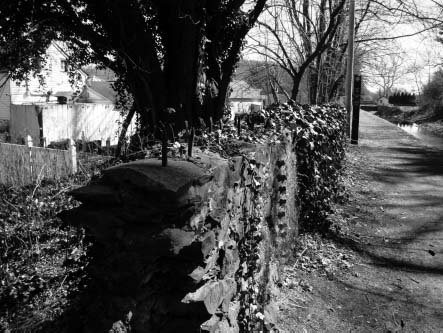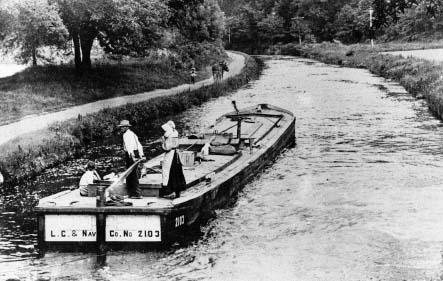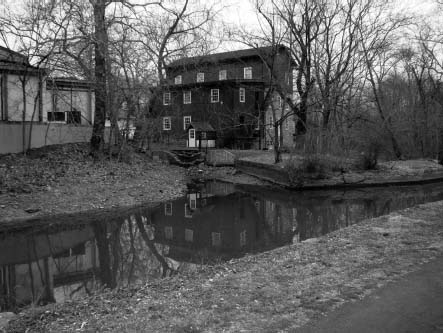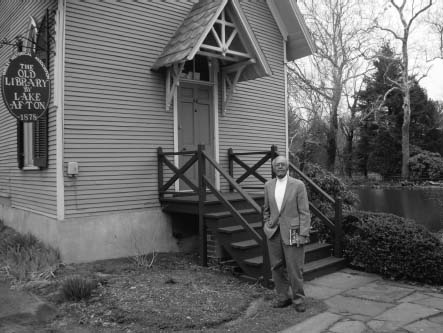The Delaware Canal (17 page)
Read The Delaware Canal Online
Authors: Marie Murphy Duess

When boats passed going in the same direction, the slow boat was expected to move to the berm side, stop and allow the other boat to pass. Again, a twenty-dollar penalty was charged if this regulation was violated. But a violation of this sort would often lead to a fight long before the canal bosses even knew about it, and in one incident of record, the violence turned to murder.
Captain Thomas Dougherty stopped his boat, but it wasn't tied up, and the bow drifted out into the canal and blocked the passing of a boat operated by John Wildonger. Wildonger asked Dougherty to move the boat several times, but Dougherty did nothing. As a result, an argument ensued, with Wildonger throwing a watermelon rind at Dougherty and Dougherty responding by throwing chunks of coal. Wildonger threw his ice hook at Dougherty, striking him in the neck. The injured man fell overboard and was pulled out by the captain of a third boat, Captain James Thompson. Dougherty died a few minutes later. At his trial, Wildonger and his crew testified that he acted in self-defense, although Thompson contradicted that story. After an hour of deliberation, the jury inexplicably returned a verdict of not guilty.
When the hinge boats were empty, the middle portion of the vessel was slightly lower than the bow and stern, and in order to compensate, the canal captains attached turnbuckles to cleats on each half at the hinge that would draw the center of the boat up to allow for easier towing and steering, especially along areas of the canal that were more difficult to navigate. One of those points was a six-mile stretch just above Ground Hog lock.
At this section of the canal, a team of mules pulling a loaded boat stopped for a drink at the overflow. The driver happened to be on the boat at the time with the captain. Because of the strong current, the boat didn't slow up and it passed the mules. Before the men onboard could react, the mules were drawn into the canal and were pulled down by their harnesses and traces. A Newfoundland dog that was on the boat jumped into the canal, grabbed the lead mule's bridle and pulled the mules to shore.
67

Stone walls along the canal in New Hope were built with spikes to keep the canallers off the walls while they waited for their turn to go through the locks.
Author's collection
.
The wiser farmers and residents along the canal took advantage of the monotony of the trip up and down the canal for the boatmen. If the boatmen were accused of helping themselves to a wayward chicken crossing the towpath and dining on fat, ripe tomatoes that had been growing along the berm, then it was fair game when farmers placed bottles along their fences, knowing that the bored boatmen would be unable to resist the temptation to pitch coal to see how many bottles they could knock down. In a good year, the farmers could warm their homes for many days and nights with the coal they collected after one of these challenges.
Where There Are Kings, There Are Queens
The wives and children of boatmen either lived on the boat year-round with the captains or took several trips with them during the summer months. Wives could be as durable and capable as their husbands. They cooked, they steered and, when necessary, they drove the mules and snubbed the boat at the locks.
One day Dr. Magill of New Hope, a man who was very respected by the canallers, was fetched to deliver a baby on one of the canalboats. The physician made it just in time to deliver the baby, then left mother and child on the cabin's bunk to go on his rounds. He was astounded to find the new mother at the tiller of the boat the very next morning, her infant in the other arm.
The women gave birth to their babies on the boats, tied their children to the decks of the boats so that they wouldn't fall off and did their best to make the tiny cabins homey and warm. They bathed themselves and their children in the cold water of the canal, and come wash day, the women would bring their wooden washtubs on deck to launder their clothes and hang a line from one end of the boat to the other to dry them. The “facilities” were the bushes along the towpath or a pail or chamber pot in the cabin. Even in the best of circumstances, a boat provided primitive accommodations.
In good weather, and especially when wives would take the trip with their husbands, tie-up areas were filled with music and dancing. Accordions, violins and harmonicas came out of the cabins, and everyone was in good voice, singing songs about canal life, with new lyrics written and put to the melodies of songs from the “old country.” The Germans yodeled, the Irish waxed poetic and
all
danced to waltzes and polkas. They put aside their disagreements and fatigue and celebrated life as only hardworking, life-loving folk can do.
During the Civil War, when the canal men went off to fight, many of their wives, daughters and sons too young to fight took over the operations of the boats and locks. Although it was a hard life for women, supporting their children while their husbands fought a war was impetus enough to leave their homes on land for the cabins of their snappers and hinge boats.

Boatmen often brought their families with them for occasional trips, and sometimes families lived on the canal year-round.
Courtesy of the Pennsylvania Canal Society Collection, National Canal Museum, Easton, PA
.
The Turnout
When the canal needed to be repaired for major damages, usually as a result of freshets or storms, the canal men didn't work, and there was no such thing as unemployment insurance then. When the “season” was cut short, so were the wages. Damages from the flood of 1841 were still being made in 1843, and the boatmen who had anticipated a prosperous year were bitterly disappointed when a series of additional breaks in the banks occurred just as they started down the canal.
Boats were backed up in Easton. Canallers sat on their coal-filled boats with nowhere to go and nothing to do, their tempers growing hotter as they realized that the delays would result in lower wages for yet another year. They gathered in groups, railing against the company and becoming more inflamed as another sixty days went by without work.
When the canal was finally opened, the boatmen declared a “turnout,” meaning they were on strike. They demanded assurance of regular work and higher wages to make up for the pay they had lost. The Mauch Chunk miners joined them in solidarity, much to the dismay of Josiah White and the LC&N. They held their ground as long as they could, but in the end, the boatmen lost. And when they went back to work after their strike, they had gained nothing, but had lost even more time and more wages.
Chapter 9
Human Cargo
They came in the dark of night. They huddled in secret subterranean rooms. They crawled through underground tunnels. They buried themselves in straw-filled wagons. And they stowed away inside the coal holds of canalboats.
The North Star was their guide. They were always looking north, running north, racing toward their right to be free and to be treated with equality.
During the early years of settlement, Pennsylvanians, including Quakers, owned slaves. The doctrines of the Quaker religion were contrary to the practice of slavery and very strong Quaker opponents began to rail against their brethren who seemed to disregard the precepts that all people were equal in the sight of God. Even George Fox, who was the founder of the Society of Friends, preached against slavery but didn't take strong action against it. William Penn was himself a slave owner, with several slaves serving at Pennsbury Manor, his country home in Bucks County.
But those who believed slavery was immoral began to travel throughout Quaker towns and villages, preaching that it was an aberration to the Quaker faith. One of these men was Anthony Benezet, a French-born Quaker who was renowned for his fight against slavery. He was able to convince Benjamin Franklin and Benjamin Rush to lead the Pennsylvania Society for Promoting the Abolition of Slavery. Soon, other prominent abolitionistsâsuch as Lucretia Mott, Anna Dickinson, Ann Preston, Jane Swisshelm and Susan B. Anthonyâbecame more vocal in supporting the cause against slavery. The Pennsylvania Abolition Society raised funds to purchase slaves and immediately set them free. Thaddeus Stevens, who was elected to the House of Representatives in 1859, was an unrelenting foe of slavery.
In March 1780, the Act for the Gradual Abolition of Slavery was passed by the Pennsylvania Assembly. It called for the
gradual
release of every Negro and mulatto child born within the state after the act was passed. Once released, they would be given the same rights as servants that had been bound by indenture for four years. It wasn't perfect, but it was a start, and slavery did decline in Pennsylvania after the passing of this act.

The gristmill in Yardley, which is located along the canal, was also a “station” on the underground railroad.
Author's collection
.
There was a large settlement of former slaves located in Columbia, Pennsylvania. This settlement was a refuge for those who fled from bondage in Virginia, Maryland and other Southern regions close to Pennsylvania. Once the fleeing slaves reached that area, slaveholders had a very difficult time finding them. Before long, the slaveholders were saying that slaves must be escaping in some sort of “underground railroad.” The expression took hold, and soon there were “conductors” who guided “passengers” from “station” to “station” (homes or buildings that would hide them). Then there were “stockholders,” who financed the organization. Secrecy was crucial to success, and as a result there are very few documents that lay out the routes, name the slaves or identify the “railroad workers.”
Many of the stationmasters and conductors were free black men, but without the assistance of the Pennsylvania, New York and New Jersey white abolitionists and sympathizers to the cause of freedom, they could not have been as successful as they were. Mostly Quakers, they housed, fed and clothed the fugitive slaves, then passed them on to the next conductor. They learned the code words and symbols, and they worked in the middle of the night. They knew very little about the next station or the people involved so that when the slave catchers came to their doors, they really wouldn't have much to tell. They were breaking the law, and they risked the freedom of their own African American friends and servants. Under the Fugitive Slave Law of 1850, suspected fugitives had no right to a jury trial and could not testify on their own behalf when brought before a magistrate. Free black men and women could be taken by slave hunters and forced into slavery if they were “suspected” of being fugitive slaves. As a result, Pennsylvanians were silent about their work and brought as little attention to themselves and the work they were doing as possible.

